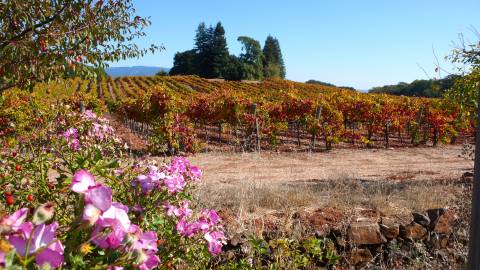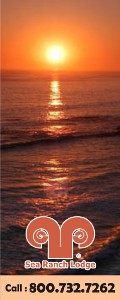Sonoma Mountain Video
Playlist:
Sonoma Mountain
Sonoma Mountain
Four million years ago, an east-facing slope of Sonoma Mountain blew open, sending molton rock and hot ash raining out over the upper valley. Remnants of the eruption are everywhere: large obsidian bolders, veins of ash, erratic variations in soil, extensive marine deposits, all characteristics of the ancient violence that shaped this hauntingly beautiful area. Sonoma Mountain itself rises to a peak of 2463 feet, while the sleeping volcanic range stretches from southern Santa Rosa southeastward over 15 miles to the Carneros wetlands, forming the western rim of Sonoma Valley . It is one of the county’s most distinguishing features yet most of us see it only from a distance.
. It is one of the county’s most distinguishing features yet most of us see it only from a distance.
Although the mountain itself and much of the countryside that surrounds it are within the large viticultural area of Sonoma Valley , a portion of this rustic region was declared an AVA in its own right in 1985, largely through the efforts of Patrick Campbell of Laurel Glen
, a portion of this rustic region was declared an AVA in its own right in 1985, largely through the efforts of Patrick Campbell of Laurel Glen Winery and David Steiner, who planted his first vineyards here in 1973. Sonoma Mountain is entirely within the boundaries of Sonoma Valley
Winery and David Steiner, who planted his first vineyards here in 1973. Sonoma Mountain is entirely within the boundaries of Sonoma Valley ; the three wineries and couple of dozen vineyards here are entitled to use either designation.
; the three wineries and couple of dozen vineyards here are entitled to use either designation.
Wine grapes--notably, cabernet sauvignon--are the dominant crop on the mountain, and virtually the only commercial agricultural endeavor within the boundaries of the viticultural area. On the southern flank above Penngrove, there are several dairy farms and dozens of colonies of bees that belong to Hector Alvarez, yet these activities lay beyond the AVA’s borders. Within the AVA, there are productive gardens, including one at the Sonoma Mountain Zen Center, but no commercial farms. Ulysses Van der Kamp, whose father founded Van der Kamp sparkling wine in 1981, grows pumpkins, several varieties of melons, asparagus, strawberries, plums, persimmons, pomegranates, cherries, apricots, apples, and Asian pears, but not commercially, not yet anyway.
“I just like to grow things,” he commented from the kitchen of the Redwood Ice Arena where he works as chef, adding that some sort of farm stand is probably inevitable, given his garden’s abundant harvest.
As a young man, Martin Van der Kamp lived at the old Swallow Ranch, now known as Skyles Ranch, above a farm that would become his so many years later. Both he and his son recall watching Russell Cundiff tend his fruit trees, berry vines, and vegetable crops that he sold to customers who came at the farm. Cundiff planted some of the area’s first pinot noir as early as the 1950s. Now, Van der Kamp and a large extended family tend the land he once coveted, and wake each morning to the sound of gongs from the Zen center next door. “Perhaps that’s why my grapes seem blessed,” he muses.
He retired his label with the 1993 vintage. “I loved the art of it,” he said during a telephone conversation from Molokai, where he was surfing and fishing, “but not the business of it.” His son now manages the 25-acre vineyard, and the grapes are sold to several premium wineries, including Landmark in Kenwood, Siduri in Healdsburg, and Flowers in Cazadero. Martin Van der Kamp remains an articulate and outspoken advocate for Sonoma Mountain, signing the praises not of cabernet sauvignon, but of the pinot noir that once went into his label’s Midnight Cuvee. He is not alone in his feeling that pinot noir may emerge as the star of the mountain.
David Steiner planted cabernet sauvignon on the Santa Rosa side of the mountain in 1973, but recently he’s turned his attention towards the Burgundy temptress. “I think Sonoma Mountain is a very good place for pinot noir,” he says, “there is a lot of coastal influence on the west side, particularly from the wind. There is full sun all year long, but it’s not hot so you have light intensity without heat.” Several growers compare the region to Russian River Valley , where pinot noir has established itself as the premier performer. Elevation is crucial; Steiner’s vineyards are around 1000 feet above the valley floor, Van der Kamp’s as high as 1600 feet in some places. There is a temperature inversion as you ascend, and it is these cooler temperatures that fuel expectations.
, where pinot noir has established itself as the premier performer. Elevation is crucial; Steiner’s vineyards are around 1000 feet above the valley floor, Van der Kamp’s as high as 1600 feet in some places. There is a temperature inversion as you ascend, and it is these cooler temperatures that fuel expectations.
The potential of pinot noir is only part of the story. There are at least two distinct growing regions within the Sonoma Mountain appellation, the east-facing or Glen Ellen side, and the Santa Rosa-Petaluma side, with its west and northwest orientation. The Glen Ellen side, sheltered as it is from the afternoon breezes rushing through the Petaluma Gap, can be quite hot, ideal for the cabernet sauvignon that has been considered the jewel of the mountain, its success well documented by the success of numerous vintages.
“Sonoma Mountain cabernet is not like any other cab,” Rod Berglund of Joseph Swan Vineyards explained recently. Swan is, of course, in Russian River Valley
explained recently. Swan is, of course, in Russian River Valley , but the winery has made Sonoma Mountain-designated wines for years, since the late Joe Swan fell in love with its chardonnay decades ago. Currently, the winery has three Sonoma Mountain wines available, a ‘96 cabernet, a ‘97 pinot noir, and the last chardonnay from the Wolfspierre Vineyard, which sold recently.
, but the winery has made Sonoma Mountain-designated wines for years, since the late Joe Swan fell in love with its chardonnay decades ago. Currently, the winery has three Sonoma Mountain wines available, a ‘96 cabernet, a ‘97 pinot noir, and the last chardonnay from the Wolfspierre Vineyard, which sold recently.
“There is a richness on the palate that I find unusual in a cabernet,” Berglund continues, “the tannins are round and soft at the same time, there’s richness without big tannins. . . these grapes really are about the expression of a place, of terroir.”
“Clearly, this is cabernet country,” Patrick Campbell says. Campbell came to winemaking slowly, after taking degrees in English Literature and Philosophy of Religion, working as a cellist with various local and Bay Area orchestras, and living at the Zen Center for three years, where he got his first glimpse of the area’s vineyards. He purchased his mountain property in the late 1970s and for several years sold his grapes to other wineries before launching his own label.
Campbell makes only cabernet sauvignon, and makes it in the style he likes to drink. Laurel Glen Vineyards is his signature label, known for its graceful cabernets that age elegantly. The reputation of the mountain is in large part based on these wines.
Vineyards is his signature label, known for its graceful cabernets that age elegantly. The reputation of the mountain is in large part based on these wines.
Most wineries identify their various wines by varietal names, appellation and vineyard designations, and price, leaving the customer to sort out the offerings. Laurel Glen is different. Only the winery’s best estate cabernet sauvignon goes to market bearing the moniker. Counterpoint, a second label, is reserved for those lots of wine that don’t meet the Laurel Glen
is different. Only the winery’s best estate cabernet sauvignon goes to market bearing the moniker. Counterpoint, a second label, is reserved for those lots of wine that don’t meet the Laurel Glen standard. A third, Quintana, includes estate grapes and grapes from elsewhere in Sonoma and Napa. Terra Rosa, a $10 cabernet once made with North Bay grapes is now made in Chile, and a fourth label, REDS, features grapes from the northern Central Valley.
standard. A third, Quintana, includes estate grapes and grapes from elsewhere in Sonoma and Napa. Terra Rosa, a $10 cabernet once made with North Bay grapes is now made in Chile, and a fourth label, REDS, features grapes from the northern Central Valley.
When asked why he maintains separate labels rather than different designations within a single label, the ever-articulate and outspoken Patrick Campbell says that, “Anything else would border on consumer fraud. It is clearer to have different labels, even if you lose some consumer awareness [of your brand] in the process.”
If Laurel Glen has built the reputation of Sonoma Mountain as a premier wine region, the Benziger family has made the area itself accessible to visitors. In the summer, hundreds make the short drive up the mountain from Glen Ellen to the vast, whimsical grounds of Benziger Family Vineyards, where the Acropolis, built by an eccentric doctor who owned the property prior to the Benzigers, overlooks a small valley.
has built the reputation of Sonoma Mountain as a premier wine region, the Benziger family has made the area itself accessible to visitors. In the summer, hundreds make the short drive up the mountain from Glen Ellen to the vast, whimsical grounds of Benziger Family Vineyards, where the Acropolis, built by an eccentric doctor who owned the property prior to the Benzigers, overlooks a small valley.
Benziger’s 85 acres of terraced vineyards sit above the valley floor in a bowl-shaped natural valley with both east and west exposure. Grapes from these vines produce the winery’s two estate wines, Tribute Red and Tribute White, blends named to honor Bruno Benziger, the family patriarch who died in 1989. Other Benziger Family wines and those of its second label, Benziger Imagery, are made from grapes from throughout California, though most come from within the county.
The winery’s tour features more than most winery visits. There’s a motorized portion with stops at educational stations featuring everything from budding, grafting, and pruning demonstrations to a visual history of the region’s earthquakes (Rodger’s Creek fault runs through the property). The education continues at the tasting room, where an exhibit shows each step in the process of cooperage, or barrel-making. Across the path from the tasting room, near a lake that is stocked with trout and catfish, is the winery’s art gallery, which houses original paintings commissioned to appear on the Benziger Imagery label series. This is the only tasting room in the appellation. (Visitors who want to explore the area more thoroughly can visit the nearby Jack London State Park .)
.)
There’s a frenzy of planting and building on Sonoma Mountain, a microcosm of what is taking place throughout the county. Tony Coturri, whose family moved here in 1964, grumbles about all the new SUVs with their arrogant, dismissive drivers crowding the country lanes—is the widenly of Enterprise Road as inevitable as the widening of 101 appears to be?—and worries about the influx of big money. Coturri has been quietly making his organic wines here since 1979, and he’s seen the mountain change as Sonoma County has been discovered not only as a premier wine region but as a wonderful place to live. Will the changes continue? Perhaps not; there are regulations and restrictions in place that could preserve the pastoral character of this magical place, even as the price of land here soars. Driving through the curving roads of Sonoma Mountain, stopping as cows cross the road from one unfenced pasture to another, it is almost possible to believe that Sonoma County’s rustic character is not all but lost.














